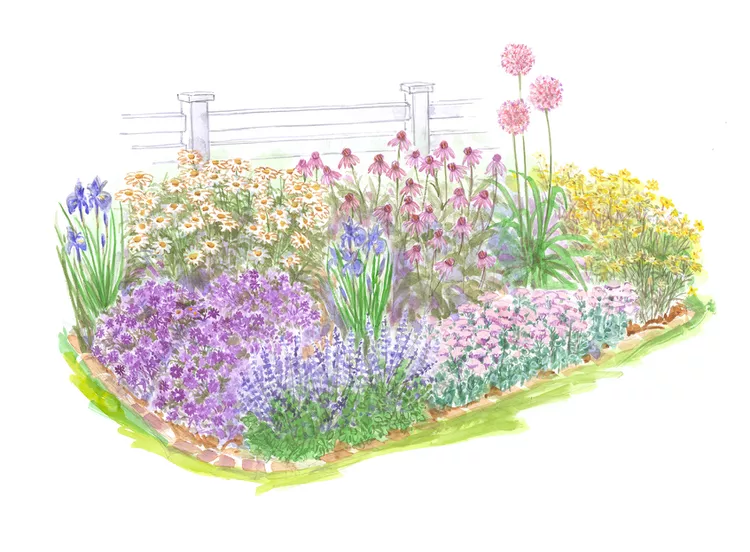New to Perennial Gardening? Try This Beginner Garden Plan for Full Sun

When planting a flower garden for the first time, it's a good idea to start out with reliable perennials that come back every year and don't require a whole lot of care. Keep the maintenance at a minimum by planting this beginner garden plan in a full sun location. The collection of plants in it will provide you with colorful blooms from spring to fall as the pinks and purples of catmint, coneflowers, and asters blend cheerfully with the warm yellows of Shasta daisies and tickseed. Other than an occasional deadheading of faded flowers, these plants will tolerate drought and heat well once established.
Plants for Creating the Beginner Garden for Full Sun
- 1 Ornamental onion (Allium giganteum): Zones 4-8
- New England aster (Symphyotrichum novae-angliae 'Purple Dome'): Zones 4-8
- 3 Tickseed (Coreopsis verticillata 'Solanna Golden Sphere'): Zones 5-9
- 3 Purple coneflower (Echinacea purpurea 'Powwow Wild Berry'): Zones 3-9
- 2 Siberian iris (Iris sibirica): Zones 4-9
- 1 Shasta daisy (Leucanthemum 'Sweet Daisy Jane'): Zones 4-9
- 3 Catmint (Nepeta x faassenii 'Walker's Low'): Zones 3-8
- 3 Stonecrop (Sedum x 'Frosty Morn'): Zones 3-9
If you aren't able to find the exact cultivars listed above, substitute with others that have similar colors, shapes, and sizes (the downloadable plan includes a few alternative plants to consider). And because some plants can become overly aggressive and spread out of control in certain climates, always check which species are considered invasive in your area before planting.
Get the Free Beginner Garden for Full Sun Plan
This free garden plan is available as a printable PDF that includes an illustrated version of the planted garden, a layout diagram, a list of plants for the garden as shown, and complete instructions for installing the garden.
Tips for Planting Your New Garden
Preparation is the key to creating a garden that will offer a lifetime of pleasure. Before you start plant shopping, review all garden plan materials. Then, ask yourself the following questions:
Do I have a suitable spot for this plan?
The layout diagram shows the rough dimensions for the plan. In general, you can enlarge or reduce the size of the garden by adding or eliminating plants, although the character of the garden may change if you alter the size dramatically.
Do I have the right growing conditions?
Check the plant list to see if the plan will do best in sun, part shade, or full shade. Be sure that the plants are suited to your USDA Hardiness Zone.
Do I need to amend my soil?
Most plants thrive in moist, but well-drained soil. If you have soil with lots of sand or clay, amend it liberally with lots of organic matter, such as compost. You may also want to do a soil test to see if you need to adjust the soil pH or add fertilizer before planting.